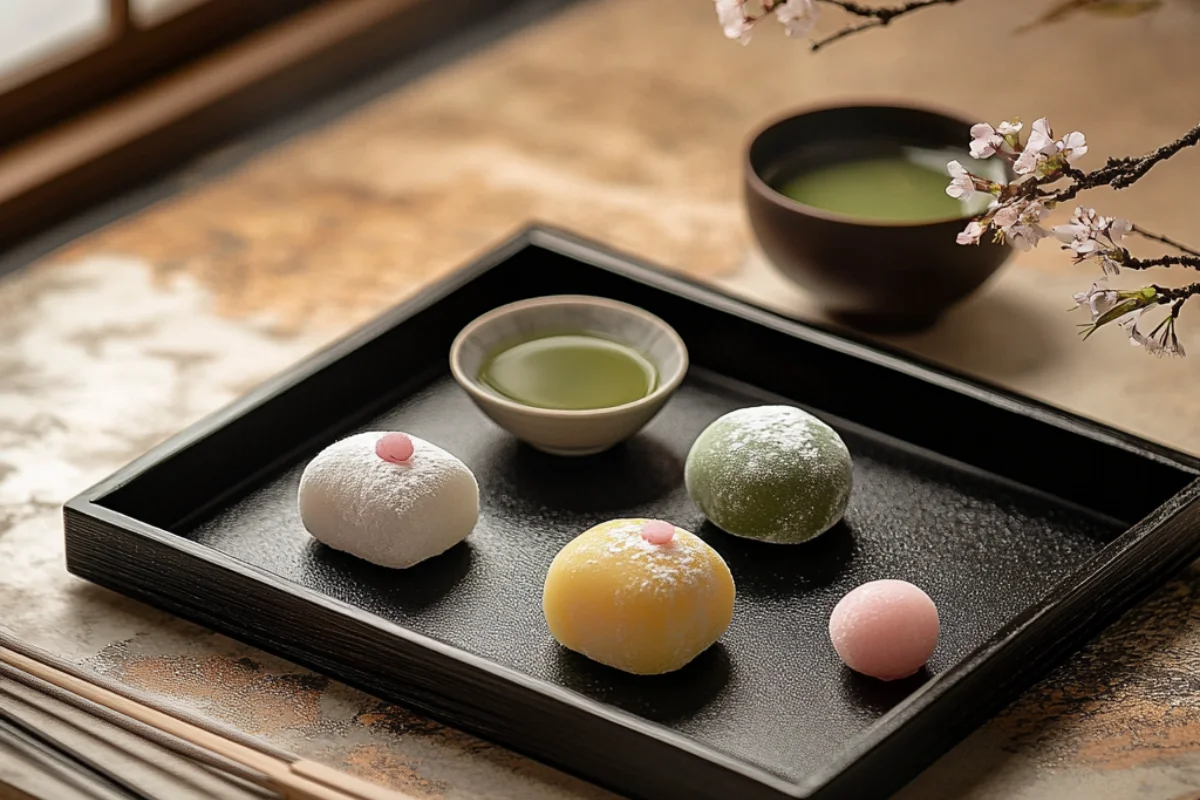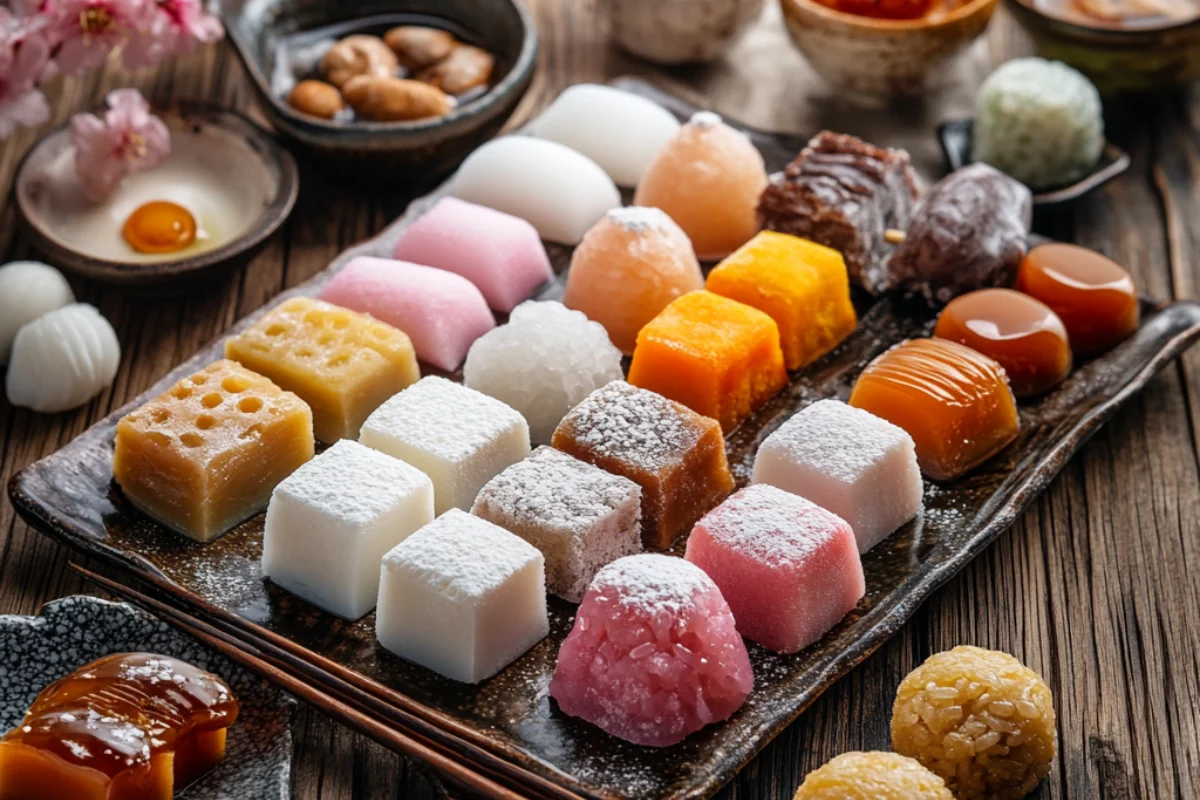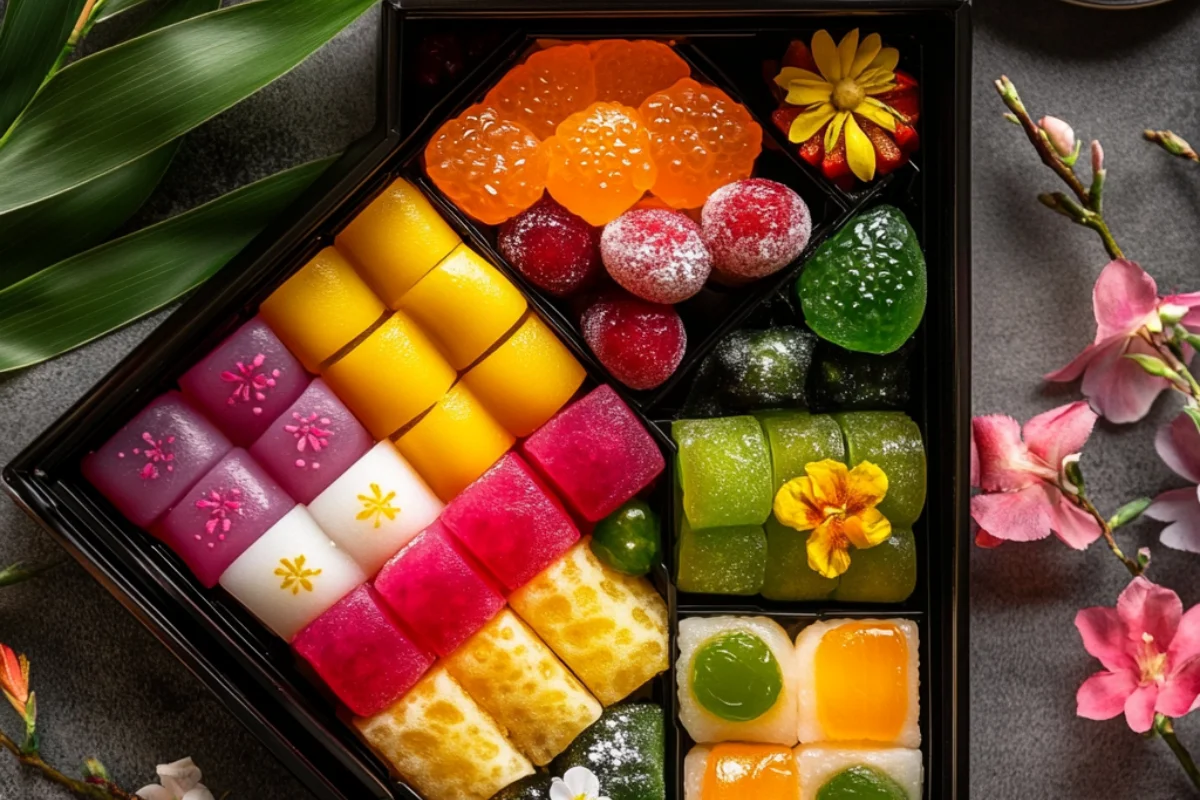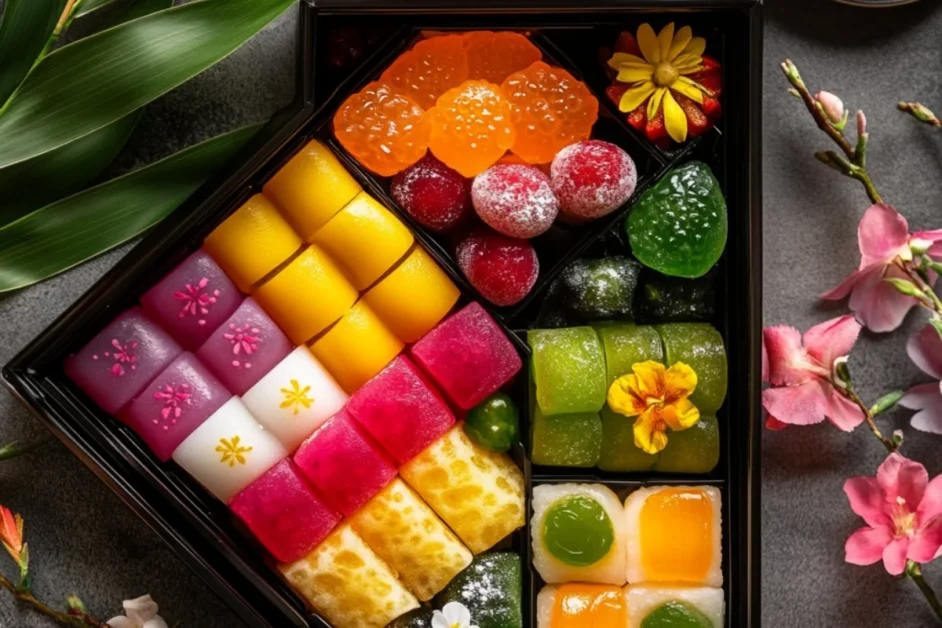Japanese Desserts: A Culinary Art
Japanese desserts, known for their delicate flavors and stunning presentation, are a true reflection of Japan’s rich culinary history and culture. From the meticulously crafted wagashi to the modern matcha-flavored delights, Japanese desserts combine art and tradition. Let’s dive into the fascinating world of Japanese desserts to understand their history, cultural significance, and their unique ingredients.
History of Japanese Desserts (Wagashi and Beyond)
The history of Japanese desserts, particularly wagashi, dates back centuries, deeply intertwined with Japan’s tea culture and seasonal celebrations. Wagashi are traditional confections often made with natural ingredients like rice flour, beans, and fruit. Their roots trace back to the Nara period (710–794), with influences from Chinese culinary traditions. However, the Edo period (1603–1868) saw the true rise of wagashi as a sophisticated art form, as they became a staple during tea ceremonies.
Beyond wagashi, Japanese desserts evolved to incorporate Western influences during the Meiji era (1868–1912), leading to the creation of fusion sweets like castella (a Japanese sponge cake inspired by Portuguese settlers). Today, desserts in Japan are a delightful blend of tradition and innovation, ranging from matcha-flavored parfaits to anime-themed taiyaki (fish-shaped cakes).
Cultural Significance of Desserts in Japan
Desserts in Japan are not merely food but an embodiment of seasonal beauty, harmony, and mindfulness. For example, wagashi are often designed to represent natural elements like cherry blossoms or autumn leaves, aligning with Japan’s love for nature.
- Tea ceremonies: Wagashi are an essential part of tea ceremonies, complementing the bitterness of matcha with their sweetness.
- Festivals: Many desserts, such as sakura mochi and kashiwa mochi, are tied to specific festivals and seasons, symbolizing good fortune and renewal.
- Gift culture: Desserts like dorayaki or daifuku are elegantly packaged and given as gifts, showcasing respect and thoughtfulness.
Key Ingredients in Japanese Desserts
Japanese desserts revolve around a few key ingredients, each contributing to their unique taste and texture.
1. Mochiko (Rice Flour)
Mochiko, a glutinous rice flour, is the foundation of many desserts, such as mochi and dango. Its elastic and chewy texture makes it a favorite in traditional and modern sweets alike.
2. Sweet Red Bean Paste (Anko)
Anko is a cornerstone of Japanese desserts, made from azuki beans and sugar. It comes in two types:
- Smooth anko (koshian), often used in delicate confections like nerikiri.
- Chunky anko (tsubuan), featured in rustic sweets like dorayaki.
3. Matcha (Powdered Green Tea)
Matcha is not just for tea—it’s a versatile ingredient in desserts, adding its distinct earthy flavor to cakes, ice cream, and parfaits.
4. Seasonal Ingredients
Japanese desserts embrace seasonality, incorporating ingredients like:
- Sakura (cherry blossoms) in spring.
- Chestnuts and sweet potatoes in autumn.
- Yuzu (Japanese citrus) in winter.
Classic Wagashi Desserts

What Are Wagashi?
Wagashi are traditional Japanese confections that are not only desserts but also works of art. They are often handcrafted to represent nature’s beauty, such as flowers or animals, and are paired with tea to balance sweetness.
Examples of Wagashi
- Nerikiri: Made with white bean paste and glutinous rice flour, nerikiri are molded into intricate shapes representing seasonal motifs.
- Yokan: A firm jelly made from anko, sugar, and agar-agar, often served in rectangular slices.
- Daifuku: Soft mochi stuffed with anko or fresh fruits, offering a delightful chewy texture.
Mochi and Its Variations
Mochi, a chewy rice cake, is a beloved staple of Japanese desserts.
Recipe for Homemade Mochi
Ingredients:
- 1 cup mochiko (glutinous rice flour)
- 3/4 cup water
- 1/4 cup sugar
- Cornstarch for dusting
Instructions:
- Mix mochiko, water, and sugar in a microwave-safe bowl.
- Microwave for 1 minute, stir, and repeat until the mixture becomes elastic.
- Dust with cornstarch, shape, and fill as desired (e.g., with anko or fruits).
Seasonal Mochi Variations
- Sakura Mochi: Pink-hued mochi filled with anko and wrapped in a salted cherry blossom leaf, enjoyed during cherry blossom season.
- Kashiwa Mochi: Filled mochi wrapped in an oak leaf, traditionally eaten during Children’s Day.
Anko-Based Desserts
How to Make Anko Paste
Ingredients:
- 1 cup azuki beans
- 1/2 cup sugar
- Pinch of salt
Instructions:
- Soak azuki beans overnight, then simmer until tender.
- Mash and mix with sugar and salt, cooking until thickened.
Popular Anko Desserts
- Dorayaki: Fluffy pancakes sandwiched with anko.
- Taiyaki: Fish-shaped cakes filled with anko, custard, or chocolate.
Matcha Desserts
Introduction to Matcha
Matcha’s umami-rich and slightly bitter taste pairs beautifully with sweet flavors, making it a popular ingredient in desserts.
Recipes
- Matcha Ice Cream: A creamy dessert blending matcha powder with milk and sugar.
- Matcha Cake: A moist sponge cake infused with matcha, often layered with whipped cream.
- Matcha Parfait: A layered dessert featuring matcha ice cream, jelly, and toppings like red beans or mochi.
Modern Japanese Desserts and Fusion Recipes
Modern Japanese desserts are a delightful marriage of traditional techniques and Western influences, creating a world of indulgent and artistic confections. From fluffy soufflé cheesecakes to intricately layered parfaits, Japan has taken classic Western desserts and infused them with its unique flair. Let’s explore these innovative creations and learn how to make some of them at home!
Western Influences in Japanese Desserts
Japan’s dessert culture saw a transformation during the Meiji Era (1868–1912) when Western cakes and pastries were introduced. These foreign sweets quickly gained popularity, leading to the adaptation of ingredients like cream, butter, and chocolate into Japanese cuisine. Today, Western-inspired desserts are a staple in Japanese bakeries and patisseries, with a distinctly Japanese touch in presentation and flavor.
Popular Examples of Western-Inspired Desserts
- Strawberry Shortcake: Known for its airy sponge layers, lightly sweetened whipped cream, and fresh strawberries, this cake has become a birthday and celebration classic in Japan.
- Castella Cake: Originally brought by Portuguese traders, this simple yet moist sponge cake is made with honey for a subtle sweetness.
These desserts epitomize the Japanese love for light textures and balanced flavors.
Japanese Cheesecakes
Recipe for Fluffy Japanese Soufflé Cheesecake
Ingredients:
- 200g cream cheese
- 50g unsalted butter
- 100ml milk
- 3 eggs (separated)
- 80g sugar
- 60g flour
- 10g cornstarch
Instructions:
- Melt cream cheese, butter, and milk over low heat. Cool and whisk in egg yolks.
- Sift in flour and cornstarch to form a smooth batter.
- Beat egg whites with sugar until stiff peaks form, then fold gently into the batter.
- Pour into a lined cake pan and bake in a water bath at 160°C (320°F) for 45 minutes.
Cotton Cheesecake vs. Traditional Cheesecakes
- Japanese Cotton Cheesecake: Known for its light, airy texture and mild sweetness.
- Western Cheesecakes: Typically denser, with a richer flavor profile.
Japanese Cream Puffs (Choux Cream)
Cream puffs, or choux cream, are a Japanese favorite, featuring crisp pastry shells filled with smooth custard cream.
How to Make Light and Airy Cream Puffs
Ingredients:
- 60g butter
- 120ml water
- 70g flour
- 2 eggs
- Custard cream for filling
Instructions:
- Heat butter and water until boiling, then add flour and mix until a dough forms.
- Remove from heat, let cool, and beat in eggs one at a time.
- Pipe onto a baking sheet and bake at 200°C (392°F) for 20 minutes. Cool before filling with custard.
Flavor Variations
- Matcha Cream: Blend matcha powder into the custard.
- Chocolate Cream: Add melted chocolate for a decadent twist.
- Strawberry Cream: Mix pureed strawberries into the filling.
Japanese Parfaits
Assembling a Japanese Parfait
Japanese parfaits are visually stunning desserts served in tall glasses, featuring layers of ice cream, fresh fruits, mochi, and jelly.
Steps to Assemble:
- Start with a base layer of crushed cookies or sponge cake.
- Add a scoop of matcha or vanilla ice cream.
- Layer with red bean paste, mochi, or fresh strawberries.
- Top with whipped cream and a decorative garnish like a cherry or wafer.
Fusion Idea: Matcha Tiramisu Parfait
Combine matcha cream, mascarpone cheese, and sponge cake soaked in matcha syrup for a Japanese twist on tiramisu.
Japanese Roll Cakes
Roll cakes are another fusion dessert loved in Japan for their soft, fluffy texture and aesthetic presentation.
Recipe for a Soft and Fluffy Roll Cake
Ingredients:
- 4 eggs
- 80g sugar
- 40g flour
- 20ml milk
- Whipped cream for filling
Instructions:
- Beat eggs and sugar until fluffy. Sift in flour and gently fold.
- Add milk for a smooth batter. Bake in a flat tray at 180°C (356°F) for 10 minutes.
- Once cooled, spread whipped cream, roll tightly, and refrigerate.
Decorative Ideas
- Add cocoa powder to the batter for a marble effect.
- Decorate the roll with patterns of seasonal motifs like sakura or snowflakes.
Japanese Puddings
How to Make Purin (Japanese Caramel Custard)
Ingredients:
- 3 eggs
- 250ml milk
- 50g sugar
- Caramel sauce (sugar and water boiled until golden)
Instructions:
- Whisk eggs, sugar, and warm milk together.
- Pour the mixture over caramel in small ramekins.
- Steam or bake in a water bath at 160°C (320°F) for 30 minutes.
Variations
- Baked Purin: Richer and firmer.
- Steamed Purin: Softer and creamier.
Ice Creams and Kakigori
Introduction to Kakigori
Kakigori is a beloved summer treat made of finely shaved ice topped with syrup and sweetened condensed milk. Popular flavors include:
- Matcha
- Strawberry
- Melon
Homemade Ice Cream Recipes
- Black Sesame Ice Cream: Blend toasted black sesame seeds into a creamy base.
- Matcha Ice Cream: Mix matcha powder with milk, cream, and sugar.
- Yuzu Ice Cream: Add yuzu juice and zest for a refreshing citrus flavor.
Japanese Doughnuts
Recipe for Pon de Ring (Mochi Doughnut)
Ingredients:
- 100g mochiko
- 50g tapioca flour
- 50g sugar
- 100ml milk
Instructions:
- Mix all ingredients into a dough and shape into small balls.
- Arrange balls in a ring shape and fry until golden.
- Glaze with matcha, chocolate, or fruit-flavored icing.
Japanese Pancakes
How to Make Fluffy Japanese Soufflé Pancakes
Ingredients:
- 2 eggs (separated)
- 30g sugar
- 50g flour
- 1 tsp baking powder
Instructions:
- Whip egg whites with sugar until stiff peaks form.
- Fold in egg yolks, flour, and baking powder.
- Cook the batter slowly in ring molds for a tall, fluffy texture.
Toppings
- Whipped cream and syrup.
- Fresh fruits like strawberries or bananas.
Fusion Desserts
Cross-Cultural Creations
- Matcha Tiramisu: A Japanese twist on the classic Italian dessert.
- Mochi Ice Cream: Mochi balls filled with ice cream in flavors like matcha and mango.
Western Cakes with Japanese Twists
- Yuzu Cheesecake: Add yuzu juice for a bright, tangy flavor.
- Sake-Infused Pound Cake: A moist and subtly alcoholic dessert.
Seasonal Japanese Desserts, Festivals, and Presentation

Japanese desserts are a celebration of seasonality, tradition, and artistry. They reflect not only the flavors of each season but also the cultural significance of Japan’s festivals and events. Whether it’s the light, floral tones of spring or the rich, warm flavors of winter, Japanese desserts are carefully crafted to harmonize with nature and festivities. Let’s explore how desserts transform across the seasons, their ties to Japanese festivals, and how they’re presented with unparalleled beauty.
Seasonal Japanese Desserts
Seasonality plays a central role in Japanese cuisine, and desserts are no exception. Each season brings unique ingredients and flavors, showcased in beautifully crafted confections.
Spring Desserts
- Sakura Mochi: A pink-colored mochi filled with sweet red bean paste (anko) and wrapped in a salted cherry blossom leaf. This dessert symbolizes the fleeting beauty of cherry blossoms.
- Strawberry Daifuku: A modern take on daifuku, this dessert combines sweet, chewy mochi with juicy fresh strawberries and a hint of anko.
Summer Desserts
- Kakigori: Finely shaved ice topped with syrups like matcha, strawberry, or melon. Often served with condensed milk, it’s a refreshing treat for Japan’s hot summers.
- Chilled Kanten Desserts: Made from agar-agar (kanten), these jellies are combined with fruits or anko to create colorful, cooling desserts.
Autumn Desserts
- Sweet Potato Sweets: Desserts like yaki-imo manju (sweet potato-filled pastries) highlight the rich, earthy flavors of the season.
- Chestnut-Based Treats: Kuri manjū and mont blanc (Japanese-style chestnut cream cakes) are autumn favorites.
Winter Desserts
- Oshiruko: A comforting red bean soup with chewy mochi pieces, perfect for cold winter days.
- Yuzu-Flavored Treats: Desserts like yuzu jelly or cakes bring a bright, citrusy note to the season.
Desserts for Japanese Festivals
Japanese festivals are a time for celebration, tradition, and, of course, sweets. These desserts are often steeped in symbolism and crafted to honor the occasion.
New Year’s Desserts
- Mochi: Essential to New Year’s celebrations, mochi represents longevity and prosperity. It’s used in ozoni soup or made into sweet rice cakes.
- Osechi Treats: Beautifully arranged in lacquered boxes, osechi includes desserts like kuri kinton (sweet mashed chestnuts).
Cherry Blossom Festivals
- Hanami Desserts: Sakura-themed sweets, like sakura mochi and hanami dango (tri-colored rice dumplings), are enjoyed during cherry blossom viewings.
Moon-Viewing Festivals
- Tsukimi Dango: These white, round rice dumplings are arranged in a pyramid shape to symbolize the harvest moon and are enjoyed during Tsukimi (moon-viewing festivals).
Bento-Style Dessert Presentation

How to Arrange Desserts in a Bento Box
Desserts in a bento box are an aesthetic feast as much as a culinary one. They are carefully arranged with an eye for color, shape, and harmony.
Tips for Beautiful Bento Presentation:
- Use dividers to separate each dessert, such as mochi, cookies, and jelly.
- Include small portions of colorful fruits or flowers to add vibrancy.
- Use natural leaves, such as bamboo or sakura, as decorative accents.
Bento Ideas for Kids and Adults
- For Kids: Fun shapes like star-shaped cookies, colorful jelly cups, or character-themed sweets (e.g., animal-shaped mochi).
- For Adults: Sophisticated desserts like matcha macarons, wagashi, or mini parfaits.
Japanese Dessert Packaging
Packaging in Japan reflects the same meticulous care as the desserts themselves. Whether it’s a gift for a friend or a personal treat, the packaging elevates the experience.
Traditional Wrapping Techniques
- Furoshiki: A reusable fabric wrap often used for gifts, adding a touch of elegance and sustainability.
- Paper Boxes: Handcrafted boxes with intricate designs that often reflect seasonal themes.
Modern Packaging Trends
Contemporary Japanese desserts are packaged with sleek, minimalist designs, often incorporating clear boxes or pastel colors. Many brands emphasize eco-friendly materials while maintaining visual appeal.
Healthier Japanese Dessert Alternatives
For those looking for lighter options, Japanese desserts can be made healthier with alternative ingredients.
Low-Sugar Versions
- Reduce sugar in anko paste and use fruit puree for natural sweetness.
- Swap syrup toppings on kakigori with pureed fruits.
Alternative Flours and Sweeteners
- Use kinako (roasted soybean flour) or almond flour for gluten-free alternatives.
- Replace sugar with natural sweeteners like honey, yuzu syrup, or stevia.
Vegan Japanese Desserts
Plant-based diets are becoming increasingly popular, and Japanese desserts are easily adaptable for vegan options.
How to Make Plant-Based Versions
- Vegan Mochi: Use water or plant-based milk instead of dairy.
- Vegan Anko: Cook azuki beans with a natural sweetener like maple syrup.
Vegan Japanese Ice Creams and Puddings
- Ice Cream: Coconut milk-based matcha or black sesame ice cream.
- Purin: A vegan caramel custard made with almond milk and agar-agar.
Dessert Pairings with Japanese Teas
Pairing desserts with tea enhances the overall dining experience.
Pairing Matcha Desserts with Teas
- Matcha parfaits or cakes pair wonderfully with sencha or genmaicha (green tea with roasted rice), balancing sweetness with earthy tea notes.
Regional Tea Pairings
- Kyoto’s Uji Matcha is perfect with light wagashi.
- Hojicha (roasted green tea) complements nutty or caramel-based desserts.
Contemporary Japanese Dessert Cafés
The café culture in Japan is thriving, blending tradition with innovation.
Trends in Japanese Dessert Cafés Worldwide
- Desserts featuring Instagram-worthy presentations, like parfait towers and floral jellies.
- Fusion items such as matcha tiramisu or mochi donuts are global favorites.
Iconic Tokyo Dessert Spots to Try
- Shiro-Hige’s Cream Puff Factory: Famous for Totoro-shaped cream puffs.
- Asakusa Kagetsudo: Renowned for its giant melon pan (sweet bread).
Japanese Street Food Desserts
Street food desserts are an integral part of Japan’s culinary scene, offering nostalgic flavors.
Popular Street Desserts
- Taiyaki: Fish-shaped cakes filled with anko, custard, or even savory fillings.
- Imagawayaki: Thick, pancake-like sweets with fillings like red bean or custard.
How to Replicate at Home
- Use a taiyaki pan for authentic shapes.
- Experiment with fillings, including chocolate or cream cheese.
Tips for Making Japanese Desserts at Home
Common Mistakes to Avoid
- Using regular rice flour instead of glutinous rice flour for mochi.
- Overcooking kanten, which can make it too firm.
- Skipping the sifting step for matcha, which may result in lumps.
Essential Tools for Japanese Dessert-Making
- A taiyaki pan or dango skewer for traditional shapes.
- Bamboo steamers for mochi and steamed desserts.
- A fine mesh sieve for smooth anko or matcha.
More FAQs About Japanese Desserts
Here are answers to 10 frequently asked questions about Japanese desserts:
1. What makes Japanese desserts unique?
Japanese desserts are known for their delicate flavors, beautiful presentation, and use of seasonal ingredients. They emphasize natural sweetness and textures, often incorporating ingredients like mochi, anko (sweet red bean paste), and matcha.
2. Are Japanese desserts typically very sweet?
No, Japanese desserts tend to be less sweet than Western desserts. The focus is on balancing flavors, such as the slight bitterness of matcha or the natural sweetness of fruits, rather than overwhelming sweetness.
3. What are some easy Japanese desserts to make at home?
Some beginner-friendly Japanese desserts include:
- Mochi: A chewy rice cake that’s simple to prepare.
- Dorayaki: Pancakes filled with sweet red bean paste.
- Matcha Ice Cream: A no-fuss treat made with matcha powder.
4. Can I make Japanese desserts without special tools?
Yes, many Japanese desserts, like pudding (purin), kanten jelly, and daifuku, can be made with basic kitchen tools. However, specialty items like taiyaki pans or bamboo steamers may be needed for specific desserts.
5. What is the difference between wagashi and modern Japanese desserts?
- Wagashi: Traditional Japanese confections often served with tea, made from ingredients like anko, mochi, and chestnuts. Examples include nerikiri and yokan.
- Modern Desserts: Heavily influenced by Western cuisine, these include cheesecakes, parfaits, and roll cakes.
6. Are Japanese desserts suitable for vegans?
Yes, many Japanese desserts are naturally vegan or can be easily adapted. For instance:
- Mochi: Made with rice flour and water.
- Anko: Vegan-friendly red bean paste.
- Kanten Jelly: Made with agar-agar instead of gelatin.
7. What’s the difference between sakura mochi and kashiwa mochi?
- Sakura Mochi: Pink mochi filled with sweet red bean paste and wrapped in a salted cherry blossom leaf. It’s enjoyed during spring festivals.
- Kashiwa Mochi: White mochi with a red bean filling, wrapped in an oak leaf, traditionally eaten during Children’s Day in May.
8. What is the most popular Japanese dessert abroad?
Matcha-based desserts are globally popular, including matcha ice cream, matcha tiramisu, and matcha-flavored cakes. Mochi ice cream is also a hit worldwide for its unique chewy texture and variety of flavors.
9. How do Japanese desserts use seasonal ingredients?
Seasonality is key in Japanese desserts. For example:
- Spring: Sakura (cherry blossoms) and strawberries.
- Summer: Yuzu and melon.
- Autumn: Chestnuts and sweet potatoes.
- Winter: Citrus flavors like yuzu and warm desserts like oshiruko.
10. What teas pair best with Japanese desserts?
- Matcha desserts pair well with sencha or hojicha.
- Sweeter treats like wagashi are perfect with matcha to balance their flavors.
- Light desserts like kanten jelly go well with floral teas, such as cherry blossom tea.

